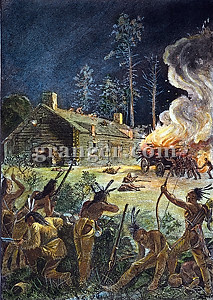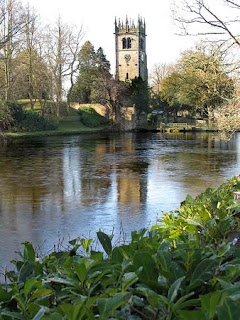Jesse was born August 14th, 1842 at Owensville, Gibson
County, Indiana. He was the son of
Ephraim Knowles and Cynthia Kimball. His
maternal grandfather, Jesse Kimball, was one of the pioneers of Gibson County.
Jesse was a Civil War Veteran who fought for the
North. At the age of 19, he enlisted in
Company A of the 58th Indiana Volunteer Infantry at Princeton, Indiana on Oct.
9th, 1861 His military records describe
him as 5’-10½” tall, dark complexion, dark brown eyes, and dark hair and listed
his occupation prior to military service as a farmer.
According to the Regimental History of the 58th Indiana
Infantry, Jessie’s military history was as follows:
This regiment was organized at Princeton in Oct., 1861,
was mustered in Dec. 17, and left the state for Louisville, where it was
assigned to Wood's division of Buell's army and marched through central
Kentucky, stopping at Bardstown, Lebanon, Spring Garden and Bowling Green.
It was at Nashville during March and left for Pittsburg
landing Apr. 1, reaching the field of Shiloh on the second day. It was engaged
in the siege of Corinth, moved into northern Alabama, then to Nashville, thence
reached Louisville Oct. 1, and joined in the pursuit of Bragg's army.
In December it marched for Murfreesboro, charged the
enemy at Lavergne on the 27th and in the three days' battle at Stone's River it
lost 18 killed 87 wounded and 5 missing.
Jessie was wounded at the Battle of Stone River, Tenn.
Dec. 31st, 1862. He sustained gunshot
wounds in the right arm near the wrist and in the left leg. He spent 3 months in various military
hospitals, first at Nashville, Tennessee, then at Louisville, Kentucky, and
finally at New Albany, Indiana before being discharged for wounds on April 7th,
1863.
After his discharged he took up residence in Gibson,
Indiana. On September 14th, 1865, he was
married to Mary Black. They were married
at the home of Harvey Westfall in Wabash County, Illinois. Mary was born March 6th, 1849 in Mr. Carmel,
Wabash County, Illinois.
While living in Indiana, Mary gave birth to two infants:
Unnamed infant, born September 24, 1866– died young
Quincy Edgar Knowles, born in 1867– died young
About 1868 the Knowles family moved to Illinois, where
two additional children were born:
William
Schuyler Knowles, born Aug. 5th, 1869 in Keensburg, Illinois – died c. 1948
Rosezella Knowles about 1871 – died young
In the 1870’s census, the family is living in Coffee,
Wabash County, Illinois. No children
were listed on the census. Mary’s
sister, Sienda was living with the family.
Jesse is listed as having real estate assets worth $ 3,000 and $ 900 of
personal assets.
About 1872, the family came to Colorado by covered
wagon. They passed through what is now
downtown Denver, where they considered setting, but, finally decided to push on
a little further before buying their property.
They settled in Spring Valley, in Douglas County. A search of the General Land office records
shows Jesse Knowles acquired 40 acres in Section 26, Township 10 south, Range
66 West, in Douglas County. The post
office where they had to travel to get their mail was in Greenland. The community is now known as Divide, and
aside from the old one room school house which is still standing and the little
cemetery, about all that is left are a few scattered farms.
The last four children born after the family moved to
Spring Valley, Colorado were:
John Lowery Knowles, born Dec. 30, 1873 – died Jul. 31st,
1900 of a brain tumor Gussie Maranda Knowles, born March 30, 1878 – died Dec.
12th, 1918 of influenza Bertha Knowles, born Jun. 13th, 1880 – died Jan. 1st,
1966, old age Cynthia Knowles, born May 8, 1883 – died Mar. 23rd, 1963
In the 1880 census, the family is living in Douglas
County, Colorado. The family of five now
includes John and Gussie as well as Schuyler.
Sienda, now Mrs. Thomas McGuire, is listed in the previous dwelling. In the 1885 Colorado state census, the family
included two additional children, Bertha & Cynthia. The McGuire family is listed on the same
page.
Jesse applied for a Civil War pension for the gunshot
wound to his right forearm. He was
granted a pension of $ 6 per month starting on April 2nd, 1888. He amended his claim to include a gunshot
wound to his left leg. His adjusted
pension of $ 8 a month was granted beginning Feb. 16th, 1889. Additional increases were granted as follows:
March 1907 $ 12 / mo. Increase
due to being over the age of 62
May 1912 $ 16 / mo. Increase
due ?
August
1912 $ 20 / mo. Increase due to reaching 70 years of age
August
1917 $ 24 / mo. Increase due to reaching 75 years of age
Even though Jesse was disabled, he was still an
entrepreneur. He was engaged in farming
his land. He added a sawmill and
supplied lumber to residents of Spring Valley.
In 1894, he and Newton Alderman opened the Spring Valley cheese
factory. In 1902 he joined J.W. Higby as
part owner of the Higby Mercantile company located in Monument, Colorado.
In 1902 he was appointed Justice of the Peace for
precinct 2. He is credited as helping to
“save the Spring Valley school from the ravages of fire and through whose
efforts the organ was procured for the school, contributed much to this Spring
Valley settlement.”
The family made their home in Spring Valley until 1905
when they moved to Orchard Park in Canon City.
There, Jesse owned one of the most successful fruit and vegetable
ranches in the area. Jesse was a member
of GAR Greenwood Post 10, Canon City (Grand Army of the Republic).
They lived in a large stone house which was the only
house of more than one story in Orchard Park.
Both met their deaths in this home, Jessie died on Feb. 27th, 1919 of
pneumonia and Mary died on Sept. 25th, 1915 of stomach cancer. They were buried in Lakeside Cemetery in
Canon City.
Jesse was described as “a man of large stature stern
appearing, but having a weakness for co-signing almost anyone's note and it was
his wife who was always expected to house and feed the traveling preachers who
often stopped by their little community in Colorado.”












